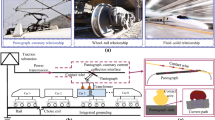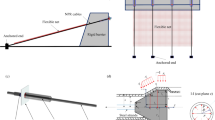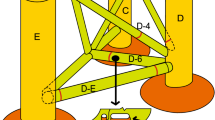Abstract
Performance of a flying cross bar, instead of the flying plate, to incapacitate the long-rod penetrator, has been evaluated numerically based on a finite element model. The length to diameter ratio, L/D, of the penetrator was 30 and the velocity was 2.0 km/s. The length of the cross bar was fixed to 0.5L and the velocity of the bar was determined from its mass and given kinetic energy. The bar was assumed to impact the mid point of the penetrator at 45° of obliquity. The efficiency of flying cross bar is maximum when the diameter of the bar is in the range between 1D and 4D depending on the energy of the bar and the distance to witness block. The protection capability of the bar has been discussed in terms of the shape and lateral displacement of the disturbed penetrator by the flying cross bar.







Similar content being viewed by others
Notes
Hitting the midpoint of the penetrator would be rare in practical situation; The cases of hitting other points will be the subject of a future work.
In Table 3, the decrease of velocity after the impact is so small; The velocity ratio (V/V o) of 0.97~0.99 may be within the margin of errors.
References
Liden E, Johansson B, Lundberg B (2006) Effect of thin oblique moving plates on long rod projectiles: A reverse impact study. Int J Impact Eng 32:1696–1720
Shin H, Yoo Y-H (2003) Effect of the velocity of a single flying plate on the protection capability against obliquely impacting long rod penetrators. Combust Explos Shock Waves 39:591–600
Yoo Y-H, Shin H (2004) Protection capability of dual flying plates against obliquely impacting long rod penetrators. Int J Impact Eng 30:55–68
Paik SH, Kim S-J, Yoo Y-H, Lee M (2007) Protection performance of dual flying oblique plate against yawed long rod. Int J Impact Eng 34:1413–1422
McIntosh G, Szymczak M (2002) Ballistic protection possibilities for a light armoured vehicle. In: Proceedings of the 20th international symposium on ballistics, Orlando, FL, USA, pp 23-27
Sterzelmeier K, Brommer V, Sinninger L (2001) Active armor protection—concept and design of steerable launcher systems fed by modular pulsed-power supply units. IEEE Trans Magnetics 37:238–241
Lee W, Lee H-J, Shin H (2002) Ricochet of a tungsten heavy alloy long-rod projectile from deformable steel plates. J Phys D Appl Phys 35:2676–2686
Shin H, Lee W (2003) Interactions of impact shock waves in a thin-walled explosive container, part I: impacts by a flat-ended projectile. Combust Explos Shock Waves 39:470–478
Shin H, Lee W (2003) Interactions of impact shock waves in a thin-walled explosive container, part II: impact by a cone-nosed projectile. Combust Explos Shock Waves 39:479–486
Shin H, Lee W (2003) Material design guidelines for explosive confinements to control impact shock-induced detonations based on shock transmission/reflection analysis. Int J Impact Eng 8:465–478
Liden E, Andersson O, Tjernberg A (2007) Influence of side-impacting dynamic armour components on long rod projectiles. In: Proceedings of the 23rd international symposium on ballistics, Tarragona, Spain, pp 16–20
Johnson GR, Cook WH (1983) A constitutive model and data for metals subjected to large strains, high strain rated, and high temperatures. In: Proceedings of the 17th international symposium on ballistics, Hague, Netherlands, pp 541–47
Liden E, Ottosson J, Holmberg L (1996) WHA long rods penetrating stationary and moving oblique steel plates. In: Proceedings of the 16th international symposium on ballistics, San Francisco, CA, USA, pp 703–11
Hallquist JO (2006) LS-DYNA Theory Manual. Livermore Software Technology Corporation, Livermore
Anderson CE Jr, Walker JD, Parton SJ, Bless Y (1996) On the L/D effect for long-rod penetrators. Int J Impact Eng 18:247–264
Anderson CE Jr, Walker JD, Bless SJ, Sharron TR (1995) On the velocity dependence of the L/D effect for long-rod penetrators. Int J Impact Eng 17:13–24
Acknowledgments
This work was financially supported by Basic Science Research Program through the National Research Foundation of Korea (NRF), funded by the MEST (2010-0004150).
Author information
Authors and Affiliations
Corresponding author
Rights and permissions
About this article
Cite this article
Yoo, YH., Paik, S.H., Kim, JB. et al. Performance of a flying cross bar to incapacitate a long-rod penetrator based on a finite element model. Engineering with Computers 29, 409–415 (2013). https://doi.org/10.1007/s00366-012-0257-y
Received:
Accepted:
Published:
Issue Date:
DOI: https://doi.org/10.1007/s00366-012-0257-y




